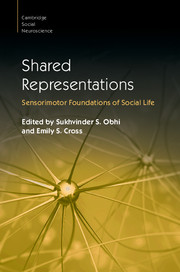Book contents
- Shared Representations
- Cambridge Social Neuroscience
- Shared Representations
- Copyright page
- Contents
- Figures
- Tables
- Boxes
- Contributors
- Preface
- Part I Foundations
- Part II Imitation and Mimicry
- Part III Thinking, Perceiving and Acting with Others
- 10 Levels of Complexity and the Duality of Gaze
- 11 Acting Together
- 12 Joint Perception
- 13 Social Antecedents and Consequences of Behavioral Synchrony
- 14 Musical Ensemble Performance
- Part IV Understanding Others
- Part V Learning and Development
- Part VI Shared Representations in Applied Contexts
- Index
- Plate Section (PDF Only)
- References
10 - Levels of Complexity and the Duality of Gaze
How Social Attention Changes from Lab to Life
from Part III - Thinking, Perceiving and Acting with Others
Published online by Cambridge University Press: 27 October 2016
- Shared Representations
- Cambridge Social Neuroscience
- Shared Representations
- Copyright page
- Contents
- Figures
- Tables
- Boxes
- Contributors
- Preface
- Part I Foundations
- Part II Imitation and Mimicry
- Part III Thinking, Perceiving and Acting with Others
- 10 Levels of Complexity and the Duality of Gaze
- 11 Acting Together
- 12 Joint Perception
- 13 Social Antecedents and Consequences of Behavioral Synchrony
- 14 Musical Ensemble Performance
- Part IV Understanding Others
- Part V Learning and Development
- Part VI Shared Representations in Applied Contexts
- Index
- Plate Section (PDF Only)
- References
Summary
Information
- Type
- Chapter
- Information
- Shared RepresentationsSensorimotor Foundations of Social Life, pp. 195 - 215Publisher: Cambridge University PressPrint publication year: 2016
References
Accessibility standard: Unknown
Why this information is here
This section outlines the accessibility features of this content - including support for screen readers, full keyboard navigation and high-contrast display options. This may not be relevant for you.Accessibility Information
- 3
- Cited by
